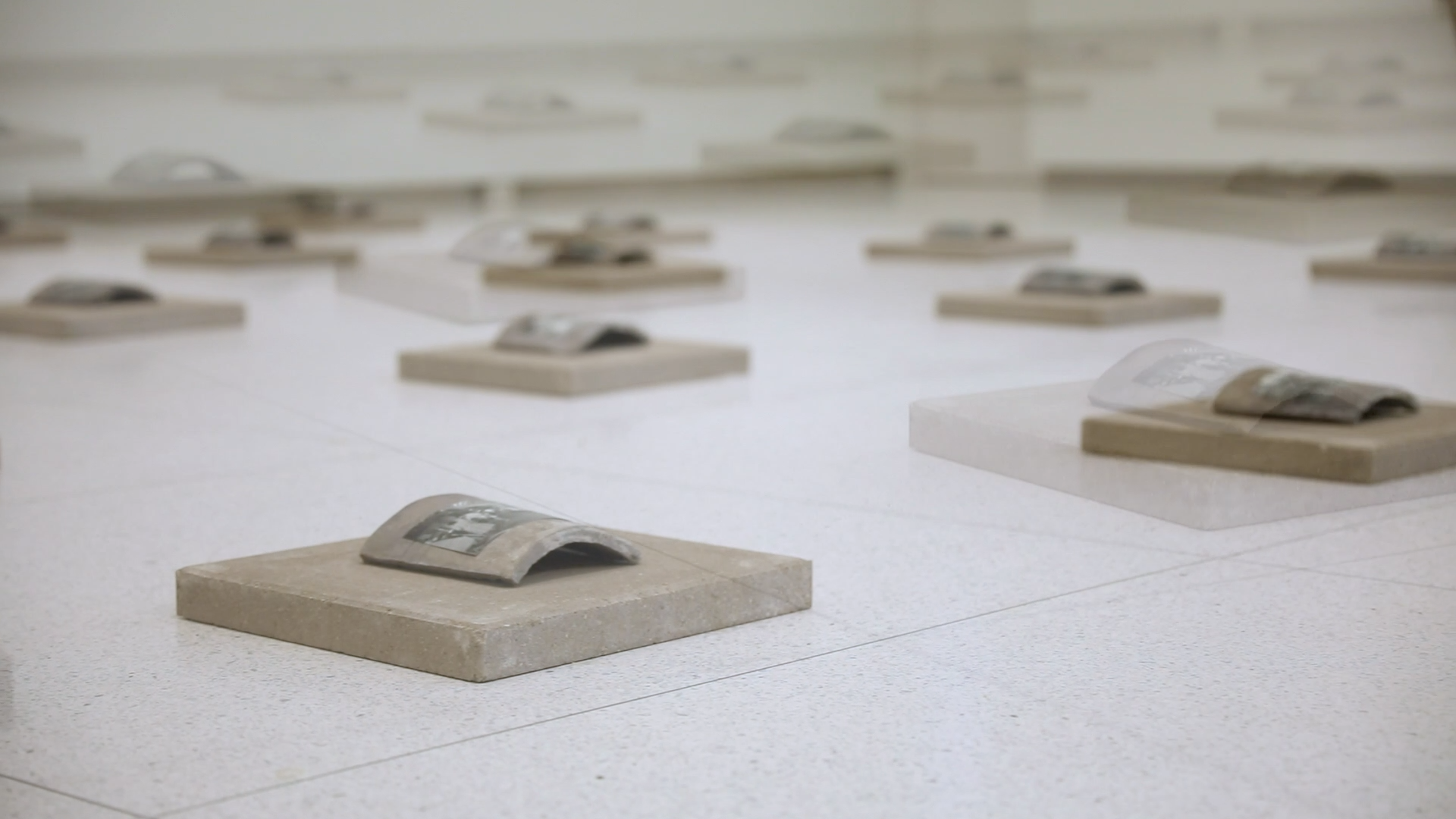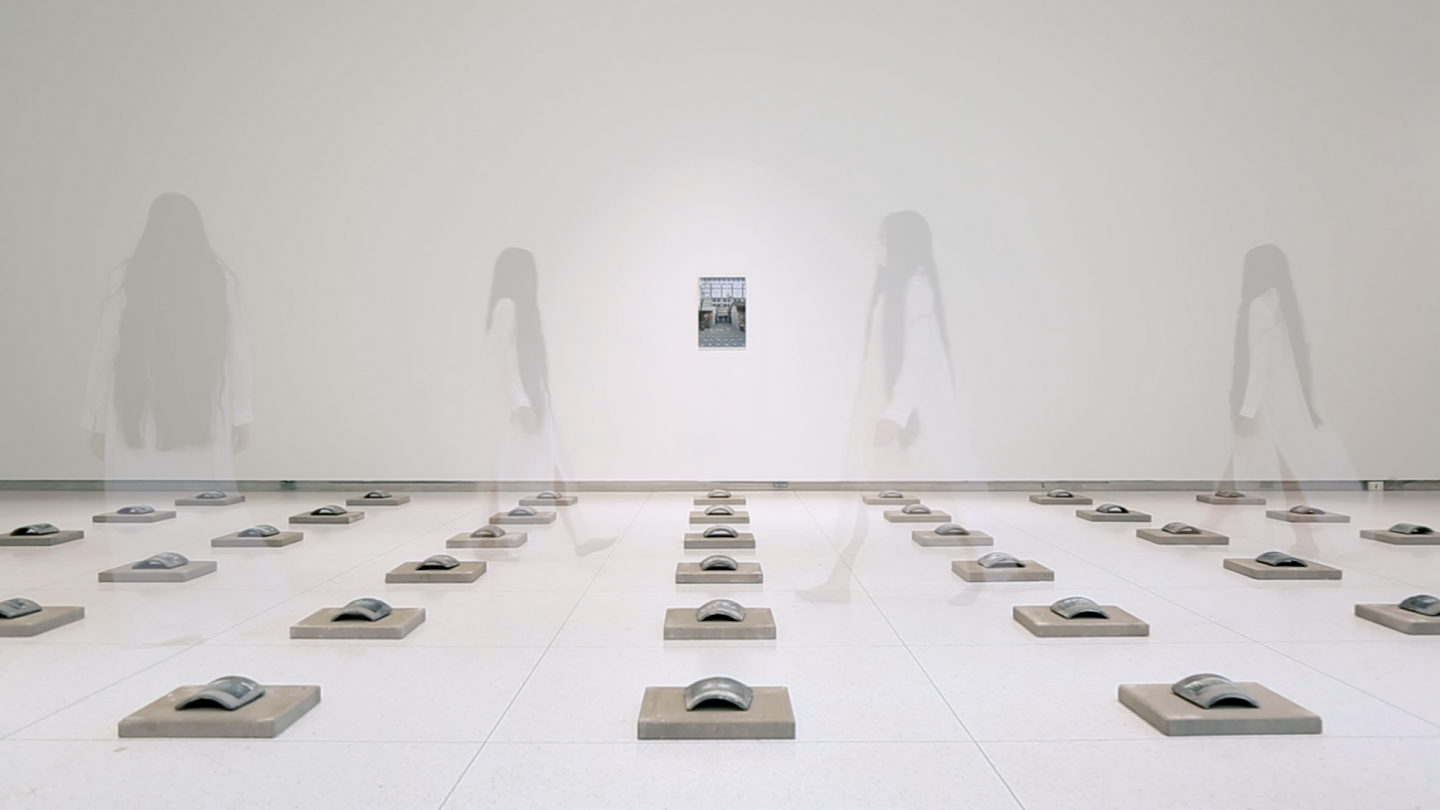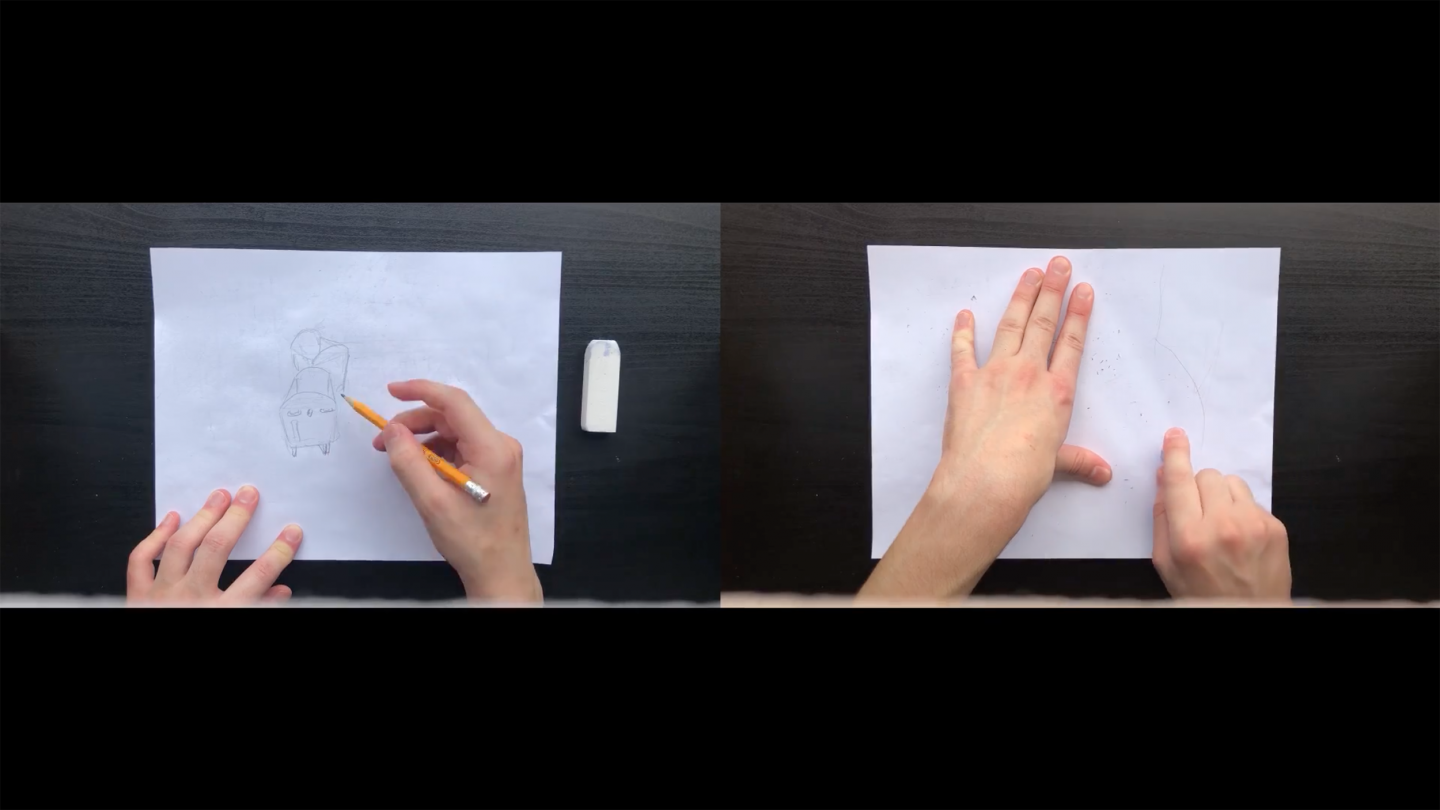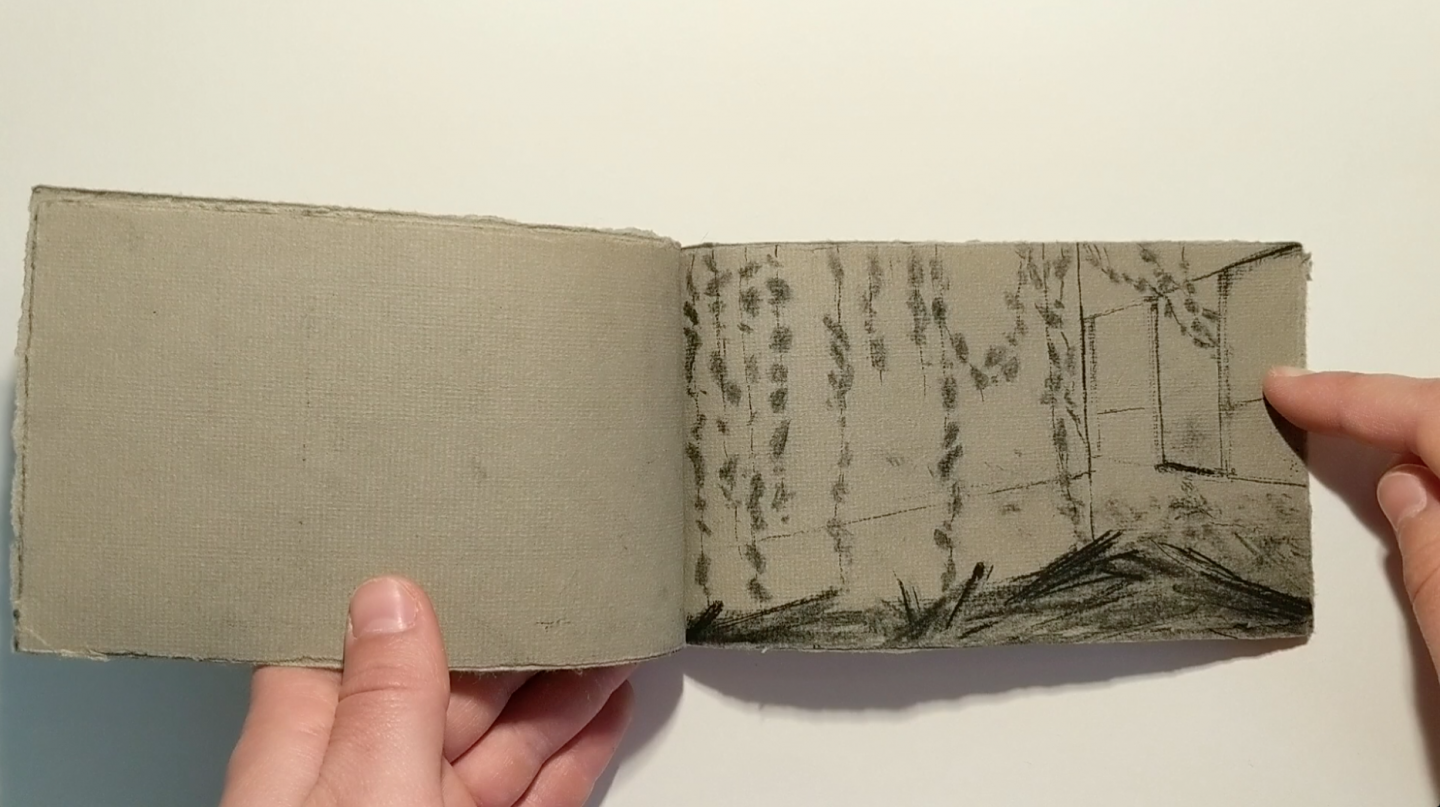Categories
Transformation

Three performances inspired by Yin Xiuzhen’s Transformation.
Transformation
Transformation, by Irene Hsiao and Vin Reed, embodies time, place, and memory. The umbrella belongs to the daily lives of passersby in the street, the past and future of protest, and the instant of photography.
تحولات
تحولات (read tahawulat, Arabic for transformations) assumes the distracted and anxious structure of spiralling thoughts, social media feeds, and diasporic longing. Employing drawing and erasing as a performance of recollection, Jad Dahshan drew scenes of their hometown Amman with pencil on paper, then materialize these memories as eraser shaving by rubbing the drawings, creating a destabilized, amorphous, and almost absurdly unreliable archive of the city.
Transformation
This booklet expands on Yin Xiuzhen’s discussion of memory in Transformation by narrowing the focus to a single memory. To create this piece, August Kellman drew the same photograph from Transformation ten times, each time working only from memory. Together, these ten drawings visually document Kellman gradually forgetting Yin Xiuzhen’s photograph and filling in the gaps in memory with imagined details—but also suggest that the tenth drawing, though different from the first, is no less truthful a memory.

Transformation
By Irene Hsiao
Yin Xiuzhen’s Transformation is made from 128 cement roof tiles scavenged from demolished buildings during the urban reconstruction of Beijing, each with a photograph, snapshots of everyday life in a city in transition: a flower, a teddy bear, a pair of slippers, phone booths, bicycles, markets, scaffolds, crowds, teakettles, animals, doors, humans. Laid out like a grid, the piece creates the space through which it is viewed. Each image is affixed along the curve of the tile, receding from the eye, interrupted by glare. People in unselfconscious motion—working, shopping, strolling, sitting, waiting—no longer here. In some, individuals appear like forgotten acquaintances. In many, human figures almost vanish into landscapes of rubble and gray.
Transformation is a piece I never wanted to experience alone. It is impossible to focus on the detail and the whole simultaneously—one must look close and far all at once, and rise and fall in obsessive ritual to navigate its dimensions. Avidly pursued, these motions result in a sickness of seeing, inducing through their embodiment the painful disorientation of place and memory associated with nostalgia. At Wrightwood 659, where the tiles stretched down the length of the floor and up the stairs, I watched visitors move through it, trickling like water through its cracks, each engaged in a private experience in a journey of their own direction and duration. Viewing it methodically, a tile at a time, inching along the grid when the grid itself is a construct of chance, architecture, and ADA regulations, felt like an artificial activity. I attempted many times but never succeeded: at some point I would stop seeing—I could not even say when. Where and what constitutes the piece? The collection of photographs, the time-bitten tiles, the paving stones that serve as the frame, the space between, the street upon which they stood in Beijing in 1997, the sections we overlooked or passed by? In the score originally composed for the exhibition, intended for performance at Wrightwood, Transformation was therefore the section that required the greatest number of performers—including the entire audience—to see.
When the museums closed for the pandemic, I similarly deferred its remembrance. Without space and others, a dancer finds herself disembodied. And is it possible to dance without a body?
But every piece in The Allure of Matter was already a dance—I learned this when I observed the installation of Zhu Jinshi’s Wave of Materials in January, a ten-day process for ten coordinated people: what appears to be a static object is created by the motions of many hands, crumpling pages in coordination, carrying rocks and bamboo, lifting, climbing, measuring. The monumental scale of many of these works are a testament to those who moved and built its parts; they are a record of motion, time, and thought.
The score had been a loose plan—a performance would have crystallized its possibilities into an experience—and yet, the experience of a live performance is as multifarious as those who attend it come with different eyes, ears, histories. Continuing with the idea of the score, which allows experience and execution to fall under the will and skill of its various performers, I offered six methods of remembering Transformation to Jad Dahshan and August Kellman—to choose, adapt, or refuse.
In تحولات, a durational practice of remembering and erasing buildings from Jad Dahshan’s hometown of Amman, Jordan, the light quick motions of hands and pencil skimming the page to render an image contrasts with the friction and tension of erasure, which appears more deliberate than the sketch. Placing creation and destruction side by side in real time produces a sense of urgency that evokes the fragility and desire of memory, as well as the mind’s role in producing and effacing it.
In August Kellman’s work, a flipbook created from drawing a single tile from Transformation again and again from memory, the slower, contemplative motions of the clean hands turning the pages belie the labor and time and physical marking of producing the images. The slow and regular turn of the pages is actually a fast-forward through the past, somewhere between stop motion and REM sleep in a book that always seems on the verge of closing. The drawings are done in charcoal, and although we do not witness their smudging, this video marks a moment before degradation—even as it keeps these images from it.
Both those pieces were conceived and begun before the Smart’s brief reopening and reinstallation of the work in the summer. When I saw Transformation again at the Smart, I was bewildered to find that 49 tiles installed there seemed to contain none of the images I remembered from the Wrightwood presentation—it had changed and so had I. The resulting video, also titled Transformation, created in an accelerated, abbreviated, and protracted process with Vin Reed, is about the passage of time, the hearing of ghosts, lost cities, and the sense that the present is ephemeral, the past eternal. The umbrella belongs to every time—the daily lives of passersby in the street, the past and future of protest, and the instant of photography. The music by Afraaz Mulji is made from a manipulated recording of an organ played in reverse.
These three works share a common theme of nonbinary identities—of genre, time, place, color, being. Yin Xiuzhen notes that people called her the “Cement Guanyin”: an androgynous goddess multiply manifested in material. We invite you to continue this investigation of time, place, and memory through your own practice—let us know with the hashtag #theAllureofTransformation

تحولات
By Jad Dahshan
Winding streets, school yards, supermarkets, mosques, public pools, and more—this ongoing video project takes from Yin Xiuzhen’s exploration of urban memory in her installation, Transformation. By recovering roof tiles from the detritus left in the wake of urban reconstruction efforts in 1990s Beijing, the artist built an installation using material charged with the memories of lost places. In contrast, lacking material access to my own hometown of Amman, Jordan, due to being quarantined in the settler-colonial United States, I resort to imbuing materials available at hand with my city’s memory. I take to remembering scenes of Amman with pencil on paper, visualizing them as drawings and materializing the memories in the eraser shavings that result from rubbing these images.
In تحولات (read tahawulat, Arabic for “transformations”), drawing and erasing are the performance of recollection. The video assumes the distracted and anxious structure of rapidly spiraling thoughts and erratic social media feeds, two connected and common features of the age of COVID-19. Opposing the relatively stable photographic and material archive of Transformation, تحولات is characterized by the instability of unsure testimonies, the mutability of memory, and the uncertainty of everything.

Transformation
By August Kellman
This booklet was conceived as a response to Yin Xiuzhen’s installation piece Transformation, which is a series of photographs of demolition sites in Beijing. The photos both document the sites and testify to the process of transformation occurring in the city. I selected a single photo from Yin Xiuzhen’s series and drew it over and over, beginning with the original photo as reference and then each successive time referencing only the preceding drawing. Eventually, I worked from memory alone. I have made many drawings of Yin Xiuzhen’s photo over the last few months; this booklet is a collection of ten drawn consecutively.
I began working on this piece in May 2020, in the midst of the COVID-19 lockdown in Chicago. At the time, I was living almost entirely indoors and was, accordingly, becoming very familiar with my four walls and increasingly forgetful of places outside my apartment. Drawing this scene became a way for me to think about the idea of “outside” and to recognize the way I could still have genuine interactions with physically inaccessible places through my memory of them. But in inhabiting my memories so immersively, I also began to understand these drawings as a story about the imaginary. The iterative process itself transformed the act of remembering into an act of creation: with each drawing, my memory became a little more distorted, but it also shifted character and picked up new emotional qualities. I encourage you to see the transformation this booklet documents as both a gradual “corruption” of my memory and an account of the creation of an imagined place and my relationship to it.
About
Irene Hsiao makes dances with visual art in museums and public spaces, a practice that includes interaction with visual artworks and experimental engagement with artists, institutions, and the public. Her work includes site-specific durational improvisation, solo theatrical dances, and video studies of art by Emmanuel Pratt, Virginio Ferrari, and Tang Chang at the Smart Museum of Art, and Philippe Parreno and Cevdet Erek at the Art Institute of Chicago. She is a 2020 Chicago Dancemakers Forum Lab Artist.
Vin Reed combines his diverse skills in graphic design, photography, illustration, and fashion in dance partnerships with companies including; Lar Lubovitch Dance Company, DanceWorks Chicago, Hedwig Dances, Dance for Life, and Same Planet Performance Project. Vin’s costume and fashion work has been featured on the NBC Morning Show, Time Out Chicago, and seen at the Museum of Contemporary Art Chicago dance retrospective “Break Out”. He has photographed hundreds of Chicago dancers and his photos of Chicago dancers have been exhibited internationally. Vin was a founding board member of DanceWorks Chicago and currently works on their advisory board. He received the award for dance advocacy in 2019 from Hedwig Dances.
Afraaz Mulji is a Tanzanian-Canadian multiinstrumentalist, conductor, composer, and DJ. They create sonic mirages that examine the essence of intersections: tangible and intangible, ambiguous and well-defined.
Jad Dahshan is a 4th year Art History student from Amman studying at the University of Chicago. They write about contemporary Arab art for artmejo and do more Chicago-focused writing for the Chicago Maroon and UChicago Arts Blog. Follow more of their work at @sad_with_a_j on Instagram.
August Kellman (b. 1992, California) is a Chicago-based artist working primarily in dry media. They earned their B.A. in History in 2014 and studied for one year at the School of the Art Institute of Chicago through the Prior Degree Program in 2018. Since then, August has been working as an art handler and continuing to create. They use their practice to think about memory and narrative and to explore questions of how the past continues to be felt in the present moment. In the next couple years, August hopes to attend architecture school.
Special thanks to Orianna Cacchione, Erik Peterson, Simone Levine, C.J. Lind, Michael Christiano, Sara Hindmarch, Ray Klemchuk, Oscar Sanchez, Jacqueline Finley, and Chicago Dancemakers Forum.